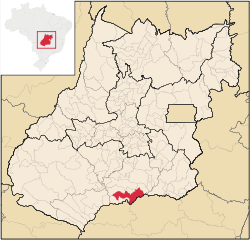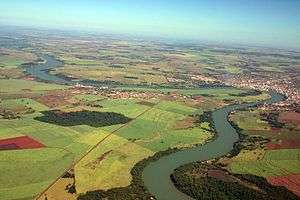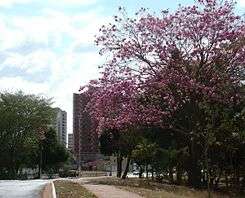Itumbiara
Itumbiara is a municipality in the extreme south of the state of Goiás, Brazil. Its population in 2018 was of 103,652 in a total area of 2,461,3 km2 (2002).[1] Itumbiara is one of the most prosperous cities in Goiás and is a major producer of soybeans, corn, cattle, and milk.
Itumbiara | |
|---|---|
Municipality | |
| Municipality of Itumbiara | |
 Flag  Seal | |
 Location in the state of Goiás. | |
| Coordinates: 18°25′0″S 49°13′0″W | |
| Country | |
| Region | Meia Ponte Microregion |
| State | Goiás |
| Founded | October 12, 1909 |
| Government | |
| • Mayor | Jose Antonio da Silva Nera (PTB) |
| Area | |
| • Total | 2.461.280 km2 (0.950 sq mi) |
| Elevation | 448 m (1,470 ft) |
| Population (2018 est.)[1] | |
| • Total | 103,652 |
| • Density | 37.71/km2 (97.7/sq mi) |
| Time zone | UTC-3 (UTC-3) |
| • Summer (DST) | UTC-2 (UTC-2) |
| HDI (2010) | 0,752 – high |
| Website | City of Itumbiara |
Geography
Itumbiara lies 197 kilometers south of the state capital, Goiânia, and is on the state boundary with Minas Gerais.
There are road connections with Goiânia and São José do Rio Preto, state of São Paulo, by the national highway, BR 153. Brazil's most popular hot springs, Caldas Novas and Rio Quente, are located a short distance to the north.
The territory of the municipality is crossed by the Paranaíba River, the Meia Ponte, the Rio dos Bois and by several small rivers and streams.
- Hamlets: Campo Limpo and Meia Ponte.
Political data
- Mayor: Francisco Domingues de Faria (Chico Bala)
- Number of council members: 10
- Total number of eligible voters: 70,240 (2012)
Demographics
- Population density in 2015: 37.71 inhabitants/km2
- Population growth rate 1996/2007: 1.04.%
- Total population in 2015: 100,548
- Total population in 1980: 78,049
- Urban population in 2010: 89,000
- Rural population in 2010: 3,942
(Sepin/IBGE)
History
In 1824 the road was completed linking Uberaba and Anhanguera on the border between Goiás and Minas Gerais. The government installed a tax collection post and the site was called "Porto de Santa Rita" or just "Porto". Soon a chapel was built dedicated to Santa Rita and the settlement was known as Santa Rita do Paranaíba, after the great river that divides Minas and Goiás. In 1909 a suspension bridge was built over the river. In 1909 Santa Rita do Paranaíba became a municipality. In 1943 the name was changed to Itumbiara (from a Tupi–Guarani language, meaning "Pathway to the Waterfall"), after a road built by Engineer Inácio Pais Leme connecting the town with Cachoeira Dourada, 40 km. away. Histórico dos Municípios In 1966 the city was made the seat of the Roman Catholic Diocese of Itumbiara.
Economy
Itumbiara is a large producer of corn, soybeans and cotton. The cattle herd is substantial, with almost one hundred and fifty thousand head of beef cows in addition to thirty thousand milking cows. There is also a large poultry raising industry. (All data below are from Sepin/IBGE)
Economic data
- Number of Industrial Establishments: 167 (/02/2007)
- Industrial District: Distrito Agroindustrial – DIAGRI (2007)
- Dairies:
- Coop. Central de Laticínio do Estado de SP Ltda. ** Miqueline e Miqueline Ltda.
- Marajoara Ind. de Laticínios Ltda (06/2007)
- Banking Establishments:
- Banco ABN AMRO Real S.A.(1) – Banco do Brasil S.A.(2)
- BRADESCO S.A (1)
- Banco Itaú S.A.(3)
- CEF (1)
- HSBC Bank Brasil S.A –Banco Múltiplo (1)
- UNIBANCO-União de Bancos Brasileiros S.A. (08/2007)
- Number of Retail Commercial Establishments: 1,180 (2007)

- Animal raising'
- Poultry: (head) 429,220 (2006)
- Cattle (head) 152,640
- Swine: (head) 14,990
- Milk cows (head): 32,030
- Main crops in planted area
- Cotton: 900 ha.
- Rice: 1,400 ha.
- Sugarcane: 11,500 ha.
- Corn: 6,550 ha.
- Soybeans: 36,500 ha.
- Sorghum: 5,300
- Agribusiness
Major agro-industrial industries are:
- Alca Foods (cereals)
- Braspelco (leather exports)
- Caramuru Alimentos (agribusiness, soy exporter)
- Grupo Maeda (cotton, soy)
- Pioneer Sementes (seeds)
- Farm Data (2006) in ha.
- Number of farms: 1,136
- Total area: 183,202
- Area of permanent crops: 1,982
- Area of perennial crops: 46,626
- Area of natural pasture: 100,370
- Persons dependent on farming: 4,000
- Farms with tractors: 440 IBGE
Education (2006)
- Schools in activity: 58
- Total Students: 25,464
- Literacy Rate: 89.0%(Sepin/IBGE 2000)
- Higher education: In July 2007 there were 3 institutions of higher education in the city. The schools were:
- ULBRA (Lutheran University of Brazil)
- UEG (Universidade Estadual de Goiás)
- UNIFASC (Faculdade Santa Rita de Cássia)
Health (2006)
- Hospitals: 3
- Beds: 232
- Infant mortality rate: 21.55 (in 1,000 live births)
(Sepin/IBGE 2000)
- MHDI: 0.782
- State ranking: 27 (out of 242 municipalities in 2000)
- National ranking: 1,018 (out of 5,507 municipalities in 2000)
For the complete list see Frigoletto

Tourism
Itumbiara's main attraction is its nautical tourism. The artificial lake Itumbiara can be used for all types of water sports. On the second Sunday of August the traditional river procession of Our Lady of the Graces takes place. Other touristic points are the Vermelhão Lake, two waterfalls, Salto de Santa Maria de Cima and Saltos de Santa Maria do Meio. The Affonso Penna Bridge, also known as the "Crystal Bridge", which links the states of Goiás and Minas Gerais. Itumbiara also has a Kart circuit, which hosts regional, national and international events, with a capacity for 5,000 people.
The city is served by Francisco Vilela do Amaral Airport.
Sister cities
Notable people
- Dante do Amaral, volleyball player
- Zé Roberto, football player
- Jorge e Mateus, Sertanejo singers
See also
References
- "Brazilian Institute of Geography and Statistics" (PDF). 2018. Retrieved 6 March 2019.
2018 Estimates of Population